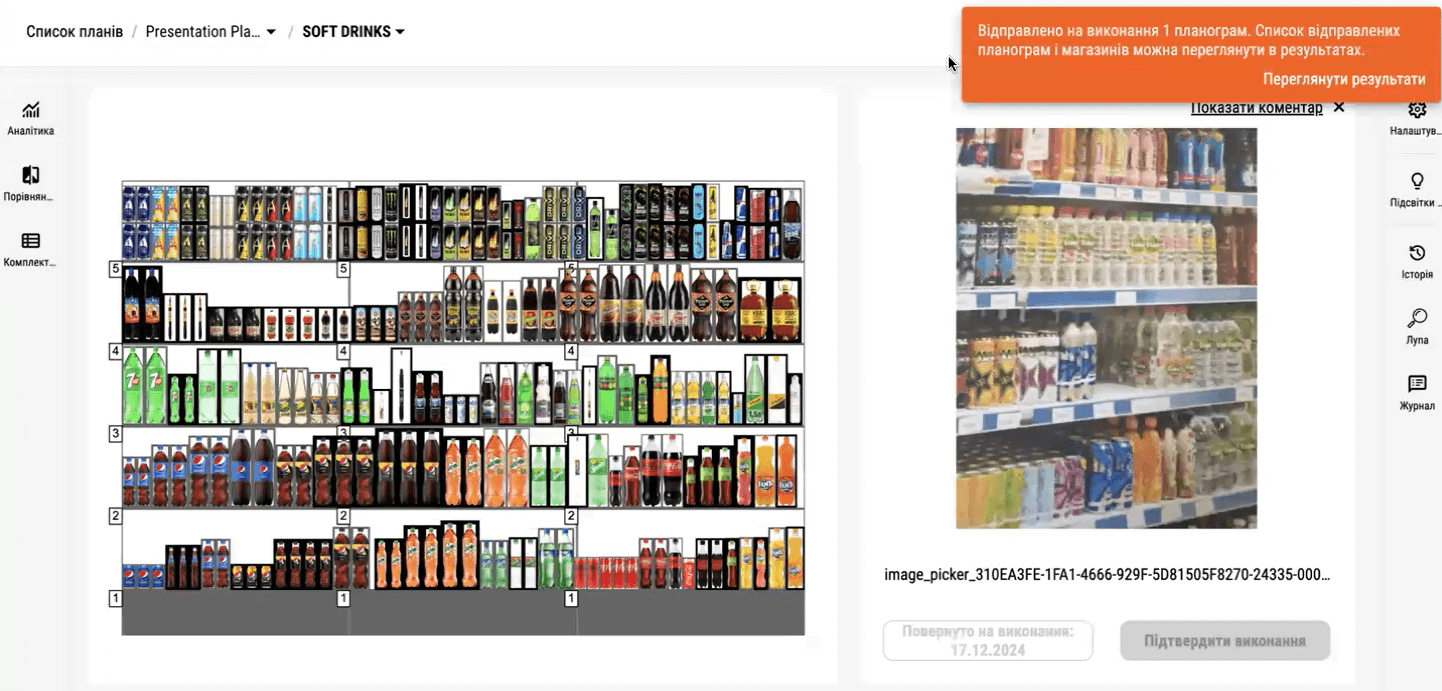Effective control over the display of goods is one of the main factors affecting sales in stores. According to research, customers make up to 60% of their decisions near the shelf, and it takes them only six seconds to make them. In today's environment, when economic instability and the consequences of a full-scale invasion affect purchasing power, layout control has become an even more important tool for maintaining and growing a business.
In 2023, many retail chains experienced a serious drop in sales, but 2024 shows a recovery, especially in food categories. At the same time, consumers are changing their habits, becoming more sensitive to promotions and discounts, and are more likely to look for the best deals between stores. This requires retail chains to have clear and consistent control over the layout of goods, ensuring customers quickly find the right product, creating a positive customer experience.
Have you ever wondered how much time a customer is willing to spend searching for the right product? Studies show that if a customer finds it difficult to find a product, 37% will choose an alternative brand, but one in five will simply go to another store. This is confirmed by real data: 20% of shoppers say they will change their shopping destination if a product is unavailable or difficult to find.
Imagine a situation where the lack of display control leads to chaos: incorrect products on the shelves, lack of key items, overcrowded promotional displays, or poor use of space. The result is lost sales and dissatisfied customers.
Effective Layout Management
Effective merchandising management is not only a matter of product presentation, but also a strategy for optimal use of retail space. One of the best tools for this is the process of merchandising automation, or as we call it, the process of planogramming, which covers the entire process from creating planograms to controlling the layout in stores and analyzing its effectiveness.
In this article, we'll discuss why display control is not a project, but a continuous process that ensures stable sales growth and customer retention.
How Product Placement Affects Sales
Product layout is not just a visual design of shelves. It is an important element that shapes the customer experience. According to research, 80% of customers regularly return to their favorite stores. However, if products are difficult to find, even loyal customers can change their habits. Sales losses directly depend on the effectiveness of product layout. The placement of products on the shelves should meet the needs of customers, their habits, and expectations.
Stages of Category Management
Effective layout begins with proper planning. Category management helps retailers create a structure of product categories that meets the real needs of the market.
- Definition of categories. The distribution of products by category should be based on customer convenience. For example, the wine category can be structured by country, color, or flavor.
- Roles of categories. Every store has different types of categories: Target - the most popular products with high penetration. Regular - products that customers buy all the time. Occasional - impulse purchases that may vary depending on the season.
- Market assessment. Analyzing market data helps determine how well the assortment meets customer needs and category roles.
-
Setting goals. What exactly do you want to achieve with each category? For example: - Attracting new customers. - Increase sales in the category. - Maximizing profits.
- Strategy development. After setting goals, a strategy is formed: expanding the assortment, introducing additional promotions, or changing the layout.
- Tactical implementation. Layout, prices, promotions - everything should be adjusted due to the chosen strategy.
- Implementation of changes. Implementation of new approaches at the store level with strict adherence to standards.
- Monitoring and adaptation. Continuous monitoring of the display, correction of errors, and analysis of results ensure continuous improvement of the process.
Why Layout Control is Critical
Poorly organized shelving can lead to a situation where the wrong products occupy important shelves, promotional products overwhelm the space, and key items are in short supply. This results in lost sales and a negative customer experience.
Without proper control:
- The assortment ceases to meet the needs of customers.
- Incorrect layout reduces the effectiveness of categories.
- Promotional items do not have the expected effect.
Layout control allows you to avoid these problems, ensuring the correct organization of shelves and maximizing profits.
Real Retailer Experience
As practice shows, stores that apply a systematic approach to display achieve the following results:
- 10-20% sales growth from optimized product placement.
- Increased customer satisfaction.
- Reduced inventory management costs.
Do you need control in your store? The answer is obvious: without it, even the best strategies lose their effectiveness.
Control as a Key to Efficiency and Growth
When there is no control, it is difficult to evaluate the effectiveness of the changes implemented. Instead of the expected result, you may face a number of problems. If promotional items are placed in the wrong places, this leads to loss of sales and reduced effectiveness of promotions. The same goes for category conflicts. Strange neighborhoods of products, such as stockings next to still water, also mean lost sales.
The lack of a holistic approach to layout affects the image of the chain. For example, if stores decide on their own how to display products, the result is chaos on the shelves.
Lack of control not only reduces the efficiency of stores, but also affects the overall level of customer satisfaction.
But even manual control has significant drawbacks:
- Unrealistic layout status: It is difficult to assess the situation in each store.
- Fake photo reports: They create an additional amount of information that is difficult to verify.
- Increased costs: The need for supervisors, transportation costs, and time for inspections constantly increases operating costs.
- Selective inspections: Manual inspection does not allow you to cover all stores and product categories.
These shortcomings lead to sales losses due to product holes, ineffective promotions, and negative customer experience.
Modern Solutions for Store Display Monitoring
Today, digital technologies allow you to effectively control the layout of products, providing:
- Remote monitoring. Thanks to web and mobile versions, you can track the implementation of tasks in the store.
- Clear planning. Stores receive clear deadlines, detailed instructions, and feedback.
- Photo confirmation. Planogramming tools automate the control process. The manager sends a photo report of the executed layout through the app. The merchandiser controls the execution of planograms by checking the received photo reports.

- Virtual shelving. AR technologies help to quickly design a shelf with a layout through the app and thus see what the planogram will look like in reality.
PlanoHero planogram software offers tools that help you customize processes for each store:
Equipment and Product Database
You can create a store layout with unique equipment and access to a database of more than 40,000 products, including dimensions and photos.
Automated Layout Rules
The system allows you to set up rules for the formation of the layout on the planogram, taking into account the parameters you need. For example, you can group products by brand, take into account sales, turnover, product categories, and within each group sort products by any parameters - size, price, and other characteristics.
3D visualization
A convenient function that allows you to see how the layout will look from all sides on the equipment, given the possibility of placing goods on top of each other.
Execution Control
Layout tasks can be easily sent to individual stores or the entire chain with fixed deadlines. The time tracker allows you to track how much time is spent on the execution, and centralized management ensures maximum efficiency of the entire process.
Process automation with PlanoHero reduces time and effort, ensures the accuracy of the layout and effective control of its implementation.
How PlanoHero Simplifies Task Execution
PlanoHero provides a convenient and efficient process for receiving and executing tasks at the store level. When a store receives a planogram, it looks like this:
Overview of Tasks and Planograms
When logged in, the store manager sees the available tasks to be completed and its store plan. This allows to conveniently plan your work and keep track of deadlines.
All tasks that need to be completed are marked on the task panel with the ability to view changes - the system will highlight in red the parts where adjustments have been made so that the store can quickly respond to updates.

Performing Tasks through the Mobile App
Employees use the mobile app to execute planograms. Main features:
The main screen displays all tasks, their status (completed/overdue), and the time spent on them.
Details of the planograms are available: shelf fullness, product positions, and changes that have been made.
Execution Tools
The mobile application PlanoHero Layout gives employees the opportunity to:
- Use a time tracker to measure the time spent on a task.
- Fix the execution with the help of photo confirmation. The photo is immediately sent for verification, which guarantees prompt control.
- Add comments in case of problems, such as lack of product or limited space.
Completing the Task
When the planogram is completed, the employee can complete the task with a real photo that is sent for verification. This allows for a high level of control and ensures that the chain receives a correctly executed planogram.
PlanoHero simplifies layout management, improves accuracy, and saves time on tasks.
Thanks to digital tools, our customers receive significant benefits, including reduced staff costs and minimized logistics risks. For example, reduced physical checks allow them to avoid frequent visits to stores, which is especially important in times of war and instability. The freed-up resources can be allocated to strategic areas, such as improving customer service or expanding the product range.
Looking for a service to create planograms?
Try a free demo version of PlanoHero




